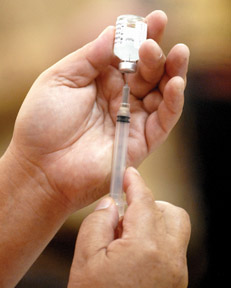Public Health Week is April 2-8 in San Benito County
Public Health Week is April 2-8 in San Benito County
San Benito County residents are invited to reflect on public health April 2-8 as the San Benito County supervisors have declared it Public Health Week, part of a national effort to emphasize the field.
Supervisor Robert Rivas presented a proclamation to Alvaro Garza, the county’s health officer, at the March 20 supervisors’ meeting.
“We want to emphasize that public health is really the whole community together, not just the workers,” Rivas said.
Garza gave a presentation to the supervisors and residents present at the meeting about the work done in the department. Community health is encompassed under several agencies in the county’s Health and Human Services Agency, including Public Health, Environmental Health and Emergency Medical Services.
“There is an assumption that we all want healthy people in our community, and it really is all of us,” Garza said.
He said public health workers may take the lead but they work with agencies he referred to as upstream, which would
include law enforcement agents, employers and others, and those who are downstream, such as hospitals and health clinics.
“Our general mission is to prevent, promote and protect,” he said.
He said the agency has some state mandates that they have to follow such as tracking statistics on communicable diseases, mortality and morbidity; health education; maternal and child health; environmental health and sanitation; and more.
Garza said San Benito County has not conducted a report on the community health status in more than a decade.
“We are in dire need of updating it,” he said. “The last report was in 2000.”
He did say that according to a national study, San Benito County was ranked second out of 56 counties for overall health outcomes. The ranking is based on mortality and morbidity statistics. Garza said the numbers reflect past conditions, since some behaviors or environmental conditions may take decades to have an effect.
When it comes to health factors – which are conditions that can affect future outcomes – such as health behaviors, clinical care, social and economic factors and physical environment, San Benito did not fare as well. It was ranked 25th out of 56 counties included in the study.
The county reported a rate of 25 percent obesity for adults; a mortality rate of 17 per capita for motor vehicle crashes; and a teen birth rate of 42.
The state averages were 23 percent, 12 per capita and 40 per capita, respectively.
One of the other health factors that could have a long-lasting impact on the community is access to clinical care. San Benito County has a ratio of one primary healthcare provider to 1,661 residents. The state average is 1:847.
The numbers are even more disparate when it comes to mental healthcare providers. San Benito has one provider for every 10,959 residents. The state average is 1:1,853.
“In regards to the county health rankings, a lot of small counties have problems bringing health providers to small communities,” Supervisor Anthony Botelho said. “Is ours as bad as these numbers show?”
Garza said that he hasn’t looked at the data, but anecdotally he has heard from many residents that they receive primary care in Gilroy, Salinas or Watsonville.
During his presentation at the meeting, Garza mentioned some of the ways the department needs to improve.
“The website is important to get information out to the community and it’s frustrating not to be able to get it up to date,” he said. “With social networks, we are not active in that either.”
He said the trend with public health departments is to get accreditation “where it meets standards of quality, much like hospitals.”
“We will be accredited soon, but a prerequisite is a community healthcare assessment, a health improvement plan and an agency or department strategic plan,” he said.
At the end of the presentation, the supervisors commented on the information.
“This has been informative to know that health can be tied to the future economics and tied to education,” Supervisor Margie Barrios said.
Supervisor Jaime De La Cruz asked if there was a correlation between health status and poverty.
Garza said it is and they try to handle it with what he called upstream services that can change the behavior of residents, such as not using tobacco products, eating healthy and exercising.
“We can change the behaviors based on what’s available to us,” he said.










